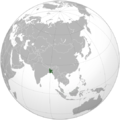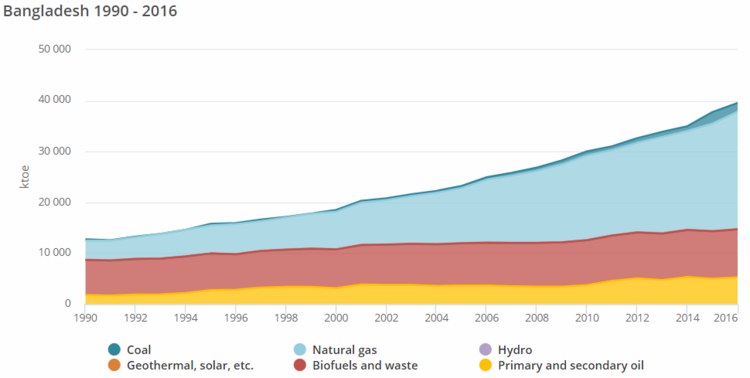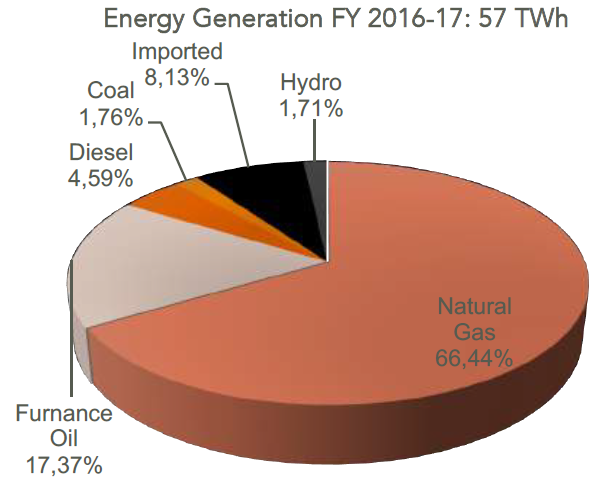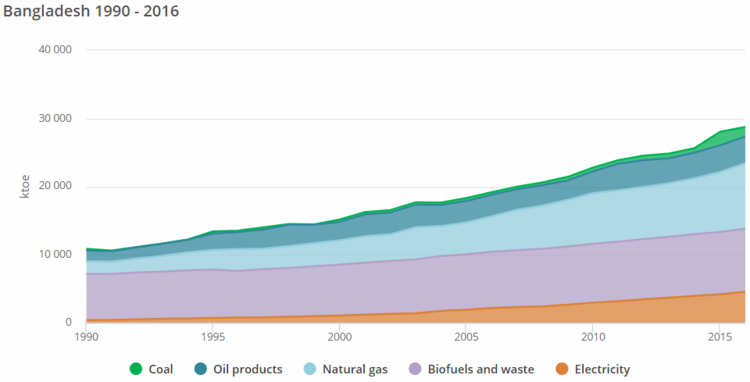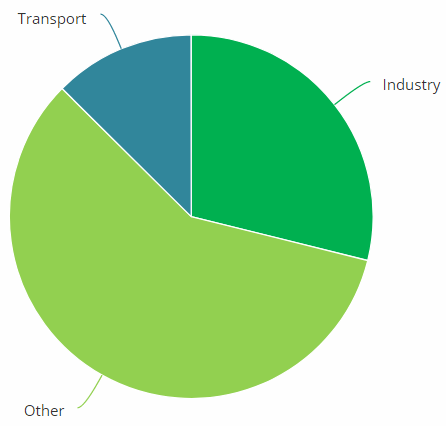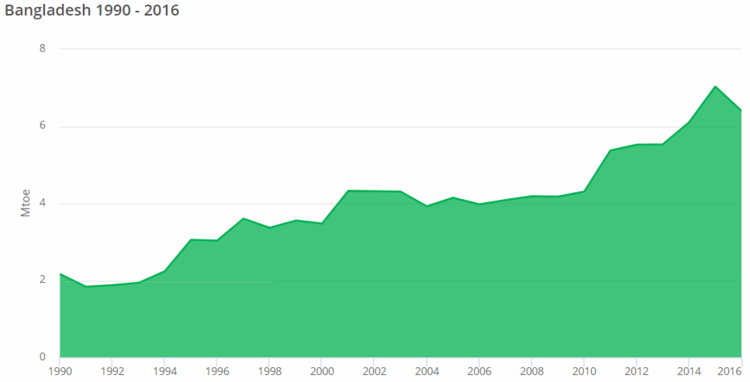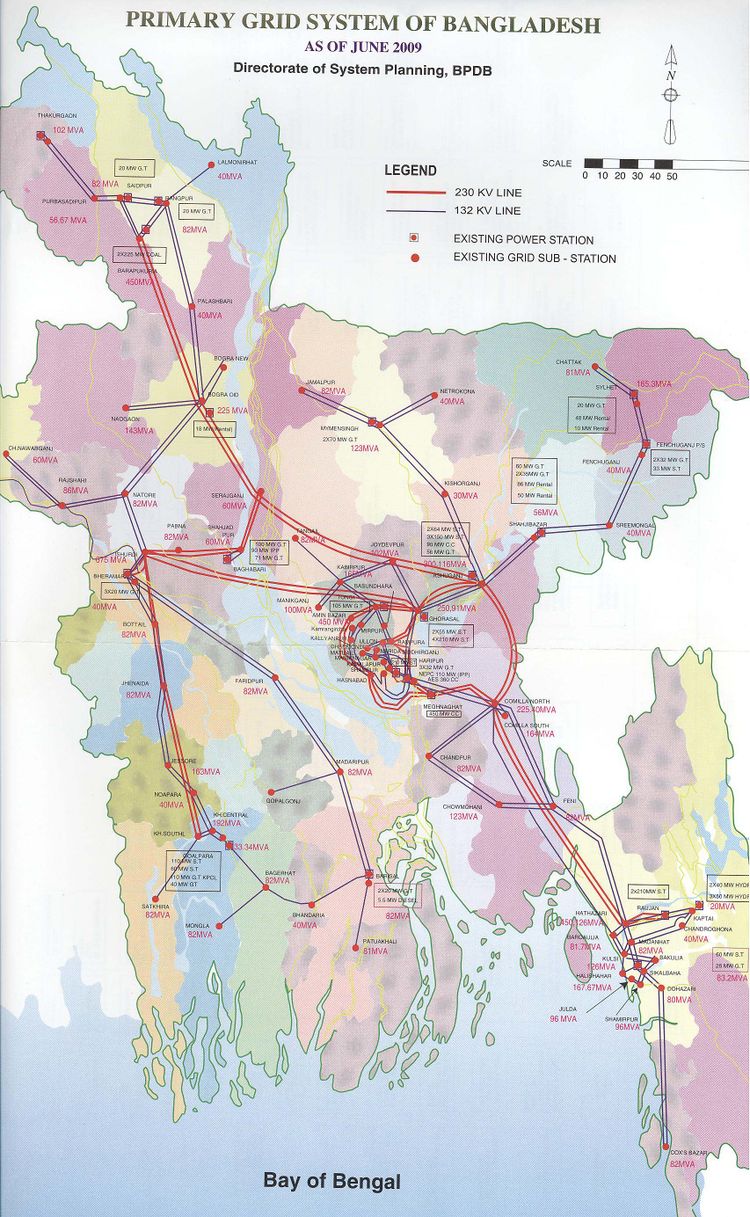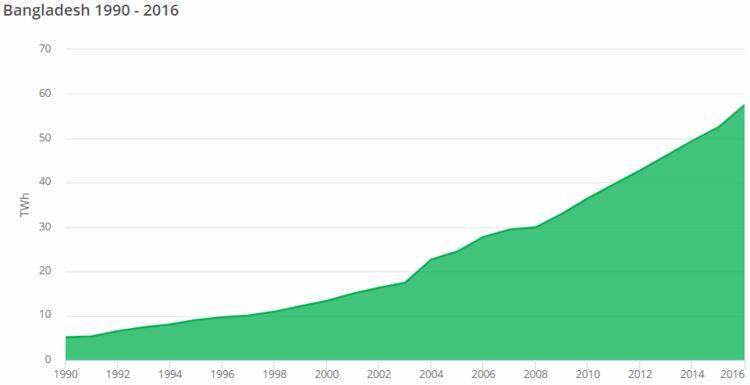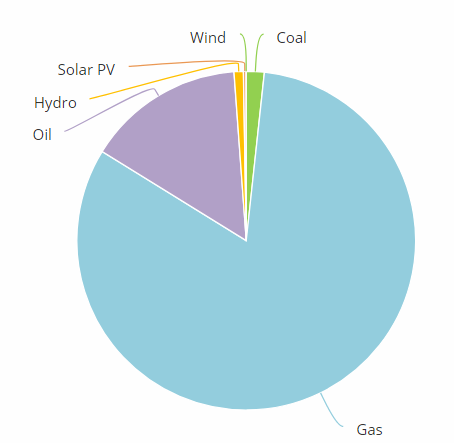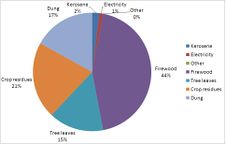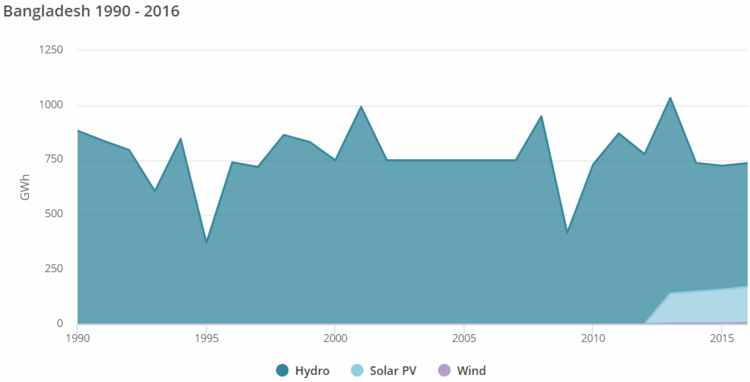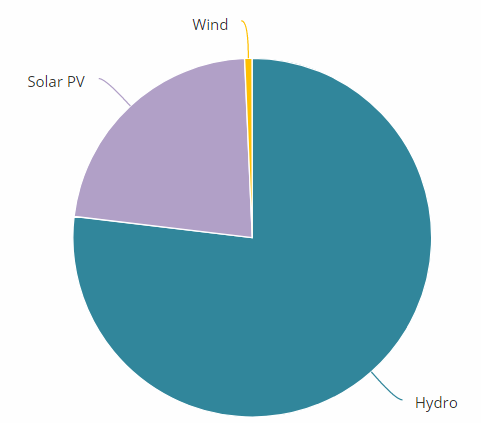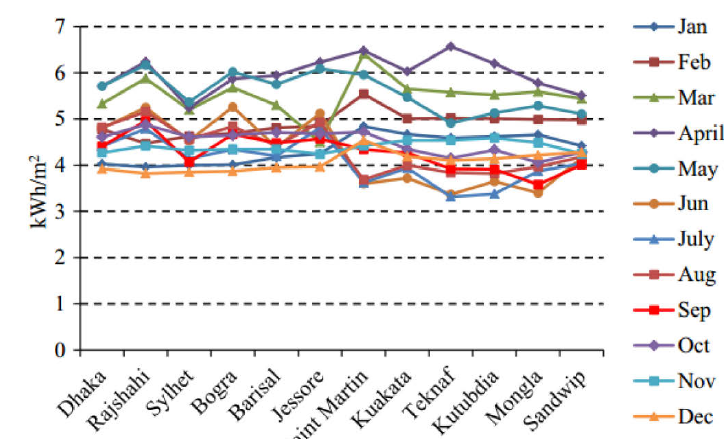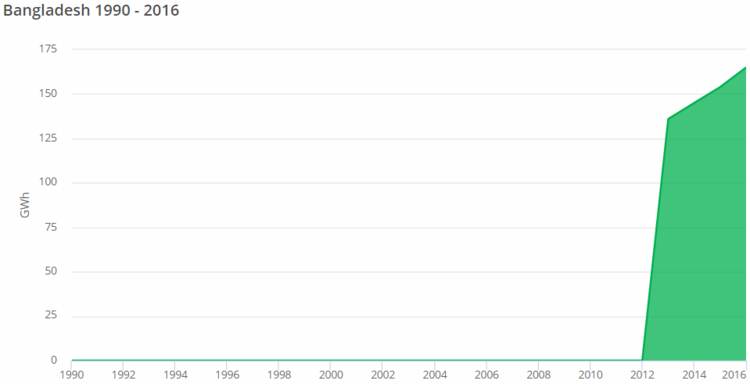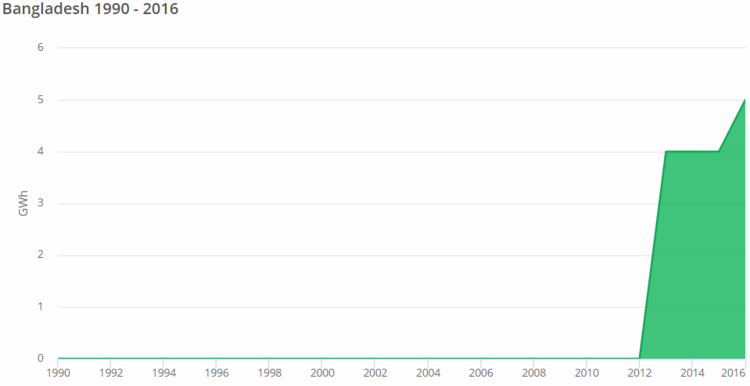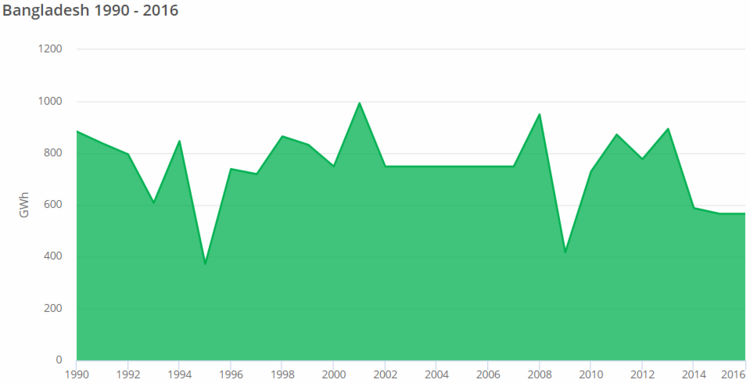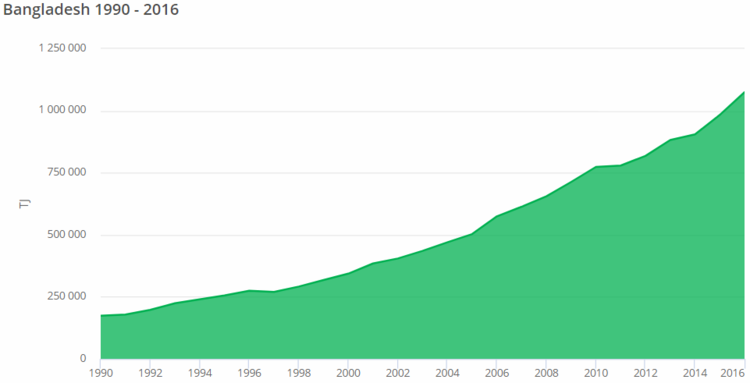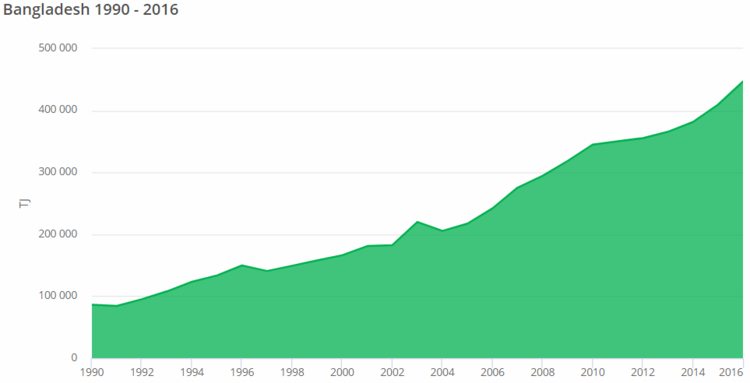Difference between revisions of "Bangladesh Energy Situation"
***** (***** | *****) m |
***** (***** | *****) m |
||
| (16 intermediate revisions by the same user not shown) | |||
| Line 406: | Line 406: | ||
|} | |} | ||
| − | |||
| − | |||
<br/> | <br/> | ||
| Line 428: | Line 426: | ||
[[File:02- Bangladesh's Total Energy Generation by Source 2016-2017 (Suntrace, 2018).PNG|thumb|center|750px|Bangladesh's Total Energy Generation by Source 2016-2017 (Suntrace, 2018)]] | [[File:02- Bangladesh's Total Energy Generation by Source 2016-2017 (Suntrace, 2018).PNG|thumb|center|750px|Bangladesh's Total Energy Generation by Source 2016-2017 (Suntrace, 2018)]] | ||
| − | |||
| − | |||
<br/> | <br/> | ||
| Line 503: | Line 499: | ||
[[File:18- Bangladesh's Total Energy Consumption 1990-2016 (IEA, 2018).PNG|thumb|center|750px|Bangladesh's Total Energy Consumption 1990-2016 (IEA, 2018)]]<br/> | [[File:18- Bangladesh's Total Energy Consumption 1990-2016 (IEA, 2018).PNG|thumb|center|750px|Bangladesh's Total Energy Consumption 1990-2016 (IEA, 2018)]]<br/> | ||
| + | |||
| + | The majority of Bangladesh's total primary consumed energy goes to natural gas, solid biomass, and waste, which are followed by oil, coal & hydro<ref name="Energy Information Administration (EIA). (2015). Bangladesh. Retrieved from: https://www.eia.gov/beta/international/country.php?iso=BGD">Energy Information Administration (EIA). (2015). Bangladesh. Retrieved from: https://www.eia.gov/beta/international/country.php?iso=BGD</ref>. | ||
| + | |||
| + | <br/> | ||
{| style="width:100%" cellspacing="0" cellpadding="5" border="1" | {| style="width:100%" cellspacing="0" cellpadding="5" border="1" | ||
| Line 542: | Line 542: | ||
== Import & Export == | == Import & Export == | ||
| + | |||
| + | The country is considered to be a net importer of crude oil and other liquid-fuels, and since the country's oil consumption is on the rise since 2010 as a replacement for natural gas's shortage, therefore, the crude oil and oil products' imports are also increasing<ref name="Energy Information Administration (EIA). (2015). Bangladesh. Retrieved from: https://www.eia.gov/beta/international/country.php?iso=BGD">Energy Information Administration (EIA). (2015). Bangladesh. Retrieved from: https://www.eia.gov/beta/international/country.php?iso=BGD</ref> | ||
<br/> | <br/> | ||
| Line 906: | Line 908: | ||
| style="width: 70px" | — | | style="width: 70px" | — | ||
|} | |} | ||
| − | |||
| − | |||
<br/> | <br/> | ||
| Line 1,110: | Line 1,110: | ||
<span style="background-color: rgb(255, 255, 255)">Bangladesh has strong potential for biomass gasification based electricity</span><span style="background-color: rgb(255, 255, 255)">. </span>Since agriculture is the main source of income for the Bangladeshi rural areas’ inhabitants, agricultural waste provides significant amounts of biomass resources, in addition to animal waste and household waste, hence the great potential of biomass in the country<ref name="Taheruzzaman, M. & Janik, P. (2016). Electricity Access in Bangladesh. Retrieved from: https://www.researchgate.net/publication/306047475_Electric_Energy_Access_in_Bangladesh">Taheruzzaman, M. & Janik, P. (2016). Electricity Access in Bangladesh. Retrieved from: https://www.researchgate.net/publication/306047475_Electric_Energy_Access_in_Bangladesh</ref>. Biomass is considered –along with natural gas- as the main energy sources in the country -consumption wise-, with biomass accounting for 70% of the country’s total energy consumption<ref name="Taheruzzaman, M. & Janik, P. (2016). Electricity Access in Bangladesh. Retrieved from: https://www.researchgate.net/publication/306047475_Electric_Energy_Access_in_Bangladesh">Taheruzzaman, M. & Janik, P. (2016). Electricity Access in Bangladesh. Retrieved from: https://www.researchgate.net/publication/306047475_Electric_Energy_Access_in_Bangladesh</ref>. <br/> | <span style="background-color: rgb(255, 255, 255)">Bangladesh has strong potential for biomass gasification based electricity</span><span style="background-color: rgb(255, 255, 255)">. </span>Since agriculture is the main source of income for the Bangladeshi rural areas’ inhabitants, agricultural waste provides significant amounts of biomass resources, in addition to animal waste and household waste, hence the great potential of biomass in the country<ref name="Taheruzzaman, M. & Janik, P. (2016). Electricity Access in Bangladesh. Retrieved from: https://www.researchgate.net/publication/306047475_Electric_Energy_Access_in_Bangladesh">Taheruzzaman, M. & Janik, P. (2016). Electricity Access in Bangladesh. Retrieved from: https://www.researchgate.net/publication/306047475_Electric_Energy_Access_in_Bangladesh</ref>. Biomass is considered –along with natural gas- as the main energy sources in the country -consumption wise-, with biomass accounting for 70% of the country’s total energy consumption<ref name="Taheruzzaman, M. & Janik, P. (2016). Electricity Access in Bangladesh. Retrieved from: https://www.researchgate.net/publication/306047475_Electric_Energy_Access_in_Bangladesh">Taheruzzaman, M. & Janik, P. (2016). Electricity Access in Bangladesh. Retrieved from: https://www.researchgate.net/publication/306047475_Electric_Energy_Access_in_Bangladesh</ref>. <br/> | ||
| + | |||
| + | <br/> | ||
| + | |||
| + | {| border="1" cellspacing="0" cellpadding="5" style="width:100%;" | ||
| + | |+ Table: Bangladesh's Total Bioenergy Capacity (MW) 2009-2018<ref name="Whiteman, A. Esparrago, J. Rueda, S. Elsayed, S. & Arkhipove, I. (2019). Renewable Energy Statistics 2019. Retrieved from: https://www.irena.org/-/media/Files/IRENA/Agency/Publication/2019/Mar/IRENA_RE_Capacity_Statistics_2019.pdf">Whiteman, A. Esparrago, J. Rueda, S. Elsayed, S. & Arkhipove, I. (2019). Renewable Energy Statistics 2019. Retrieved from: https://www.irena.org/-/media/Files/IRENA/Agency/Publication/2019/Mar/IRENA_RE_Capacity_Statistics_2019.pdf</ref> | ||
| + | |- | ||
| + | ! scope="row" | Year | ||
| + | ! scope="col" | 2009 | ||
| + | ! scope="col" | 2010 | ||
| + | ! scope="col" | 2011 | ||
| + | ! scope="col" | 2012 | ||
| + | ! scope="col" | 2013 | ||
| + | ! scope="col" | 2014 | ||
| + | ! scope="col" | 2015 | ||
| + | ! scope="col" | 2016 | ||
| + | ! scope="col" | 2017 | ||
| + | ! scope="col" | 2018 | ||
| + | |- | ||
| + | ! scope="row" | Capacity | ||
| + | | 1 | ||
| + | | 1 | ||
| + | | 2 | ||
| + | | 3 | ||
| + | | 3 | ||
| + | | 4 | ||
| + | | 5 | ||
| + | | 5 | ||
| + | | 5 | ||
| + | | 5 | ||
| + | |} | ||
<br/> | <br/> | ||
| Line 1,134: | Line 1,164: | ||
Microhydro and minihydro have limited potential in Bangladesh, with the exception of Chittagong and the Chittagong Hill tracts. Hydropower assessments have identified some possible sites from 10 kW to 5 MW but no appreciable capacity has yet been installed. There is one hydro power plant at Kaptai established in the 1960s with present installed capacity of 230 MW. | Microhydro and minihydro have limited potential in Bangladesh, with the exception of Chittagong and the Chittagong Hill tracts. Hydropower assessments have identified some possible sites from 10 kW to 5 MW but no appreciable capacity has yet been installed. There is one hydro power plant at Kaptai established in the 1960s with present installed capacity of 230 MW. | ||
| + | |||
| + | <br/> | ||
| + | |||
| + | {| border="1" cellspacing="0" cellpadding="5" style="width:100%;" | ||
| + | |+ Table: Bangladesh's Hydropower Capacity (MW) 2009-2018<ref name="Whiteman, A. Esparrago, J. Rueda, S. Elsayed, S. & Arkhipove, I. (2019). Renewable Energy Statistics 2019. Retrieved from: https://www.irena.org/-/media/Files/IRENA/Agency/Publication/2019/Mar/IRENA_RE_Capacity_Statistics_2019.pdf">Whiteman, A. Esparrago, J. Rueda, S. Elsayed, S. & Arkhipove, I. (2019). Renewable Energy Statistics 2019. Retrieved from: https://www.irena.org/-/media/Files/IRENA/Agency/Publication/2019/Mar/IRENA_RE_Capacity_Statistics_2019.pdf</ref> | ||
| + | |- | ||
| + | ! scope="row" | Year | ||
| + | ! scope="col" | 2009 | ||
| + | ! scope="col" | 2010 | ||
| + | ! scope="col" | 2011 | ||
| + | ! scope="col" | 2012 | ||
| + | ! scope="col" | 2013 | ||
| + | ! scope="col" | 2014 | ||
| + | ! scope="col" | 2015 | ||
| + | ! scope="col" | 2016 | ||
| + | ! scope="col" | 2017 | ||
| + | ! scope="col" | 2018 | ||
| + | |- | ||
| + | ! scope="row" | Capacity | ||
| + | | 230 | ||
| + | | 230 | ||
| + | | 220 | ||
| + | | 220 | ||
| + | | 230 | ||
| + | | 230 | ||
| + | | 230 | ||
| + | | 230 | ||
| + | | 230 | ||
| + | | 230 | ||
| + | |} | ||
| + | |||
| + | <br/> | ||
| + | |||
| + | [[File:30- Bangladesh's Electricity Generation of Hydropower 1990-2016 (IEA, 2018).PNG|thumb|center|750px|Bangladesh's Electricity Generated from Hydropower 1990-2016 (IEA, 2018)]]<br/> | ||
[[Bangladesh Energy Situation#toc|►Go To Top]] | [[Bangladesh Energy Situation#toc|►Go To Top]] | ||
| Line 1,139: | Line 1,203: | ||
<br/> | <br/> | ||
| − | == | + | = Fossil Fuels = |
| + | |||
| + | == Natural Gas == | ||
| − | + | Bangladesh is ranked 7<sup>th</sup> largest natural gas producer in Asia<ref name="Taheruzzaman, M. & Janik, P. (2016). Electricity Access in Bangladesh. Retrieved from: https://www.researchgate.net/publication/306047475_Electric_Energy_Access_in_Bangladesh">Taheruzzaman, M. & Janik, P. (2016). Electricity Access in Bangladesh. Retrieved from: https://www.researchgate.net/publication/306047475_Electric_Energy_Access_in_Bangladesh</ref>. Bangladeshi’s consumed natural gas is supplied by two main sources; majority, about 99.4% by the state-owned [https://www.petrobangla.org.bd/ Petro-Bangla], and the remaining 0.5-0.6% is from international oil companies<ref name="Taheruzzaman, M. & Janik, P. (2016). Electricity Access in Bangladesh. Retrieved from: https://www.researchgate.net/publication/306047475_Electric_Energy_Access_in_Bangladesh">Taheruzzaman, M. & Janik, P. (2016). Electricity Access in Bangladesh. Retrieved from: https://www.researchgate.net/publication/306047475_Electric_Energy_Access_in_Bangladesh</ref>.<br/> | |
<br/> | <br/> | ||
| − | <br/> | + | [[File:33- Bangladesh's Natural Gas Production 1990-2016 (IEA, 2018).PNG|thumb|center|750px|Bangladesh's Natural Gas Production 1990-2016 (IEA, 2018)]]<br/> |
| + | |||
| + | [[File:21- Bangladesh's Natural Gas Consumption 1990-2016 (IEA, 2018).PNG|thumb|center|750px|Bangladesh's Natural Gas Consumption 1990-2016 (IEA, 2018)]]<br/> | ||
| + | |||
| + | [[File:22- Bangladesh's Sectorial Shares of Natural Gas Final Consumption in 2016 (IEA, 2018).PNG|thumb|center|750px|Bangladesh's Sectorial Shares of Natural Gas's Final Consumption in 2016 (IEA, 2018)]] | ||
| − | + | = Key Problems of the Energy Sector = | |
| − | |||
| − | = Key Problems of the Energy Sector | ||
| − | |||
*A mere 6% of the entire population has access to natural gas, primarily in urban areas | *A mere 6% of the entire population has access to natural gas, primarily in urban areas | ||
*Electricity supply is not reliable and peak demand cannot be met | *Electricity supply is not reliable and peak demand cannot be met | ||
| Line 1,157: | Line 1,224: | ||
*Most people in the rural areas depend on kerosene lamps for light | *Most people in the rural areas depend on kerosene lamps for light | ||
*90% of all Bangladeshis cook with biomass, such as rice straw, dried leaves, jute sticks, cow dung, or wood. | *90% of all Bangladeshis cook with biomass, such as rice straw, dried leaves, jute sticks, cow dung, or wood. | ||
| + | *Energy capacity is too low<ref name="Pranti, A.S. Iqubal, M.S. Saifullah, A.Z.A. & Ahmmed, K. (2013). Current Energy Situation and Comparative Solar Power Possibility Analysis for Obtaining Sustainable Energy Security in South Asia. International Journal of Scientific & Technology Research Volume 2, Issue 8. Retrieved from: https://pdfs.semanticscholar.org/3cae/71b6006708f33b9630d18dc2a0050b04a295.pdf">Pranti, A.S. Iqubal, M.S. Saifullah, A.Z.A. & Ahmmed, K. (2013). Current Energy Situation and Comparative Solar Power Possibility Analysis for Obtaining Sustainable Energy Security in South Asia. International Journal of Scientific & Technology Research Volume 2, Issue 8. Retrieved from: https://pdfs.semanticscholar.org/3cae/71b6006708f33b9630d18dc2a0050b04a295.pdf</ref>. | ||
| + | *The energy infrastructure is quiet poor, and small compared to other countries, which makes it insufficient<ref name="Pranti, A.S. Iqubal, M.S. Saifullah, A.Z.A. & Ahmmed, K. (2013). Current Energy Situation and Comparative Solar Power Possibility Analysis for Obtaining Sustainable Energy Security in South Asia. International Journal of Scientific & Technology Research Volume 2, Issue 8. Retrieved from: https://pdfs.semanticscholar.org/3cae/71b6006708f33b9630d18dc2a0050b04a295.pdf">Pranti, A.S. Iqubal, M.S. Saifullah, A.Z.A. & Ahmmed, K. (2013). Current Energy Situation and Comparative Solar Power Possibility Analysis for Obtaining Sustainable Energy Security in South Asia. International Journal of Scientific & Technology Research Volume 2, Issue 8. Retrieved from: https://pdfs.semanticscholar.org/3cae/71b6006708f33b9630d18dc2a0050b04a295.pdf</ref><ref name="Taheruzzaman, M. & Janik, P. (2016). Electricity Access in Bangladesh. Retrieved from: https://www.researchgate.net/publication/306047475_Electric_Energy_Access_in_Bangladesh">Taheruzzaman, M. & Janik, P. (2016). Electricity Access in Bangladesh. Retrieved from: https://www.researchgate.net/publication/306047475_Electric_Energy_Access_in_Bangladesh</ref>. | ||
| + | *There is about 13.57% loss in transmission and distribution, consequently a significant amount of power is lost on its way to consumers<ref name="Pranti, A.S. Iqubal, M.S. Saifullah, A.Z.A. & Ahmmed, K. (2013). Current Energy Situation and Comparative Solar Power Possibility Analysis for Obtaining Sustainable Energy Security in South Asia. International Journal of Scientific & Technology Research Volume 2, Issue 8. Retrieved from: https://pdfs.semanticscholar.org/3cae/71b6006708f33b9630d18dc2a0050b04a295.pdf">Pranti, A.S. Iqubal, M.S. Saifullah, A.Z.A. & Ahmmed, K. (2013). Current Energy Situation and Comparative Solar Power Possibility Analysis for Obtaining Sustainable Energy Security in South Asia. International Journal of Scientific & Technology Research Volume 2, Issue 8. Retrieved from: https://pdfs.semanticscholar.org/3cae/71b6006708f33b9630d18dc2a0050b04a295.pdf</ref>. | ||
| + | *Industries lose their production due to shortage of power supply<ref name="Pranti, A.S. Iqubal, M.S. Saifullah, A.Z.A. & Ahmmed, K. (2013). Current Energy Situation and Comparative Solar Power Possibility Analysis for Obtaining Sustainable Energy Security in South Asia. International Journal of Scientific & Technology Research Volume 2, Issue 8. Retrieved from: https://pdfs.semanticscholar.org/3cae/71b6006708f33b9630d18dc2a0050b04a295.pdf">Pranti, A.S. Iqubal, M.S. Saifullah, A.Z.A. & Ahmmed, K. (2013). Current Energy Situation and Comparative Solar Power Possibility Analysis for Obtaining Sustainable Energy Security in South Asia. International Journal of Scientific & Technology Research Volume 2, Issue 8. Retrieved from: https://pdfs.semanticscholar.org/3cae/71b6006708f33b9630d18dc2a0050b04a295.pdf</ref>. | ||
| + | *Though Bangladesh has a 15 MW household solar and 1.9 MW wind power probability, the people are deprived of power<ref name="Pranti, A.S. Iqubal, M.S. Saifullah, A.Z.A. & Ahmmed, K. (2013). Current Energy Situation and Comparative Solar Power Possibility Analysis for Obtaining Sustainable Energy Security in South Asia. International Journal of Scientific & Technology Research Volume 2, Issue 8. Retrieved from: https://pdfs.semanticscholar.org/3cae/71b6006708f33b9630d18dc2a0050b04a295.pdf">Pranti, A.S. Iqubal, M.S. Saifullah, A.Z.A. & Ahmmed, K. (2013). Current Energy Situation and Comparative Solar Power Possibility Analysis for Obtaining Sustainable Energy Security in South Asia. International Journal of Scientific & Technology Research Volume 2, Issue 8. Retrieved from: https://pdfs.semanticscholar.org/3cae/71b6006708f33b9630d18dc2a0050b04a295.pdf</ref>. | ||
| + | *The state-owned electricity frequently suffer from large deficits<ref name="Mujeri, M.K. Chowdhury, T.T. & Shahana, S. (2014). Energy Sector in Bangladesh: An agenda for reforms. Retrieved from: https://www.iisd.org/gsi/sites/default/files/ffs_bangladesh_agenda.pdf">Mujeri, M.K. Chowdhury, T.T. & Shahana, S. (2014). Energy Sector in Bangladesh: An agenda for reforms. Retrieved from: https://www.iisd.org/gsi/sites/default/files/ffs_bangladesh_agenda.pdf</ref>. | ||
| + | *The poor pricing policies, resulting in the failure of the energy sector to attract adequate private investment<ref name="Mujeri, M.K. Chowdhury, T.T. & Shahana, S. (2014). Energy Sector in Bangladesh: An agenda for reforms. Retrieved from: https://www.iisd.org/gsi/sites/default/files/ffs_bangladesh_agenda.pdf">Mujeri, M.K. Chowdhury, T.T. & Shahana, S. (2014). Energy Sector in Bangladesh: An agenda for reforms. Retrieved from: https://www.iisd.org/gsi/sites/default/files/ffs_bangladesh_agenda.pdf</ref>. | ||
<br/> | <br/> | ||
| Line 1,247: | Line 1,321: | ||
= Institutional Set-up in the Energy Sector = | = Institutional Set-up in the Energy Sector = | ||
| + | |||
| + | Approximately 40% of Bangladeshi generated electricity was generated by private sector in April, 2010, and the percentages reached about 44% by April, 2011<ref name="Taheruzzaman, M. & Janik, P. (2016). Electricity Access in Bangladesh. Retrieved from: https://www.researchgate.net/publication/306047475_Electric_Energy_Access_in_Bangladesh">Taheruzzaman, M. & Janik, P. (2016). Electricity Access in Bangladesh. Retrieved from: https://www.researchgate.net/publication/306047475_Electric_Energy_Access_in_Bangladesh</ref>. The sole authority responsible for delivering electricity to the national grid, is Bangladesh Power Development Board (BPDB)<ref name="Taheruzzaman, M. & Janik, P. (2016). Electricity Access in Bangladesh. Retrieved from: https://www.researchgate.net/publication/306047475_Electric_Energy_Access_in_Bangladesh">Taheruzzaman, M. & Janik, P. (2016). Electricity Access in Bangladesh. Retrieved from: https://www.researchgate.net/publication/306047475_Electric_Energy_Access_in_Bangladesh</ref>. The BPDB also produces and purchases electricity from independent power producers (IPPs), to meet the national demand<ref name="Taheruzzaman, M. & Janik, P. (2016). Electricity Access in Bangladesh. Retrieved from: https://www.researchgate.net/publication/306047475_Electric_Energy_Access_in_Bangladesh">Taheruzzaman, M. & Janik, P. (2016). Electricity Access in Bangladesh. Retrieved from: https://www.researchgate.net/publication/306047475_Electric_Energy_Access_in_Bangladesh</ref>. | ||
| + | |||
| + | <br/> | ||
| + | |||
| + | {| border="1" cellspacing="0" cellpadding="5" style="width:100%;" | ||
| + | |+ Table: Bangladesh's Main Electricity Producers & their different Market's Shares of the Total Capacity<ref name="Taheruzzaman, M. & Janik, P. (2016). Electricity Access in Bangladesh. Retrieved from: https://www.researchgate.net/publication/306047475_Electric_Energy_Access_in_Bangladesh">Taheruzzaman, M. & Janik, P. (2016). Electricity Access in Bangladesh. Retrieved from: https://www.researchgate.net/publication/306047475_Electric_Energy_Access_in_Bangladesh</ref> | ||
| + | |- | ||
| + | ! scope="row" | Producer | ||
| + | ! scope="col" | Abbreviation & Website | ||
| + | ! scope="col" | Capacity (MW) | ||
| + | ! scope="col" | Market Share % | ||
| + | |- | ||
| + | ! scope="row" | Bangladesh Power Development Board | ||
| + | | [http://www.bpdb.gov.bd/bpdb_new/ BPDB] | ||
| + | | 4442 | ||
| + | | 42.75 | ||
| + | |- | ||
| + | ! scope="row" | Ashuganj Power Station Company Ltd. | ||
| + | | [https://www.apscl.com/home/index/en APSCL] | ||
| + | | 682 | ||
| + | | 6.56 | ||
| + | |- | ||
| + | ! scope="row" | Electricity Generation Company of Bangladesh<br/> | ||
| + | | [http://www.egcb.com.bd/ EGCB] | ||
| + | | 622 | ||
| + | | 5.98 | ||
| + | |- | ||
| + | ! scope="row" | North West Power Generation Company Ltd. | ||
| + | | [https://www.nwpgcl.org.bd/ NWPGCL] | ||
| + | | 375 | ||
| + | | 3.06 | ||
| + | |- | ||
| + | ! scope="row" | Independent Power Producers | ||
| + | | IPPs | ||
| + | | 4269 | ||
| + | | 41.08 | ||
| + | |} | ||
| + | |||
| + | <br/> | ||
| + | |||
| + | {| border="1" cellspacing="0" cellpadding="5" style="width:100%;" | ||
| + | |+ Table: Bangladesh's Main Distribution Companies<ref name="Taheruzzaman, M. & Janik, P. (2016). Electricity Access in Bangladesh. Retrieved from: https://www.researchgate.net/publication/306047475_Electric_Energy_Access_in_Bangladesh">Taheruzzaman, M. & Janik, P. (2016). Electricity Access in Bangladesh. Retrieved from: https://www.researchgate.net/publication/306047475_Electric_Energy_Access_in_Bangladesh</ref> | ||
| + | |- | ||
| + | ! scope="row" | Company/Institution | ||
| + | ! scope="col" | Abbreviation & Website | ||
| + | |- | ||
| + | ! scope="row" | Bangladesh Power Development Board<br/> | ||
| + | | [http://www.bpdb.gov.bd/bpdb_new/ BPDB]<br/> | ||
| + | |- | ||
| + | ! scope="row" | Dhaka Electric Supply Company<br/> | ||
| + | | [https://www.desco.org.bd/bangla/ DESCO] | ||
| + | |- | ||
| + | ! scope="row" | Dhaka Electric Supply Authority<br/> | ||
| + | | DESA | ||
| + | |- | ||
| + | ! scope="row" | West Zone Power Distribution Company<br/> | ||
| + | | [http://www.wzpdcl.org.bd/ WZPDC]<br/> | ||
| + | |- | ||
| + | ! scope="row" | Dhaka Power Distribution Company<br/> | ||
| + | | [https://dpdc.org.bd/ DPDC] | ||
| + | |} | ||
| + | |||
| + | <br/> | ||
== Governmental institutions<br/> == | == Governmental institutions<br/> == | ||
| − | *''Bangladesh Ministry of Power, Energy and Mineral Resources''is in charge of electrification activities as well as of improved cookstoves. The Power Division is responsible for the Country Action Plan for Clean Cookstoves (CAP). | + | *''[https://www.mpemr.gov.bd/ Bangladesh Ministry of Power, Energy and Mineral Resources] ''is in charge of electrification activities as well as of improved cookstoves. The Power Division is responsible for the Country Action Plan for Clean Cookstoves (CAP). |
| − | * | + | *[http://www.berc.org.bd/ Bangladesh Energy Regulatory Commission (BERC)]: BERC has authority over consumer protection, approval of tariffs and pricing, issuance of generation and distribution licenses, and promotion of competition. |
| − | *''Power Cell'': Within the MPEMR power division, the Power Cell oversees power sector reform. | + | *''[http://www.powercell.gov.bd/ Power Cell]'': Within the MPEMR power division, the Power Cell oversees power sector reform. |
| − | * | + | *[http://www.reb.gov.bd/ Rural Electrification Board (REB)]: REB oversees operations of consumer-owned rural electric cooperatives (PBSs). It performs supervisory and regulatory duties to ensure that technical standards are met and performance is monitored.<br/> |
| − | * | + | *[http://www.sreda.gov.bd/ Sustainable and Renewable Energy Development Agency (SREDA)]: SREDA will act as a focal point for sustainable energy development and promotion, ‘sustainable energy’ comprising renewable energy and energy efficiency. (This institution is not established yet but concrete steps have been taken in this regard by the Government, with SED support).<br/> |
| − | * | + | *[http://180.211.137.22:8991/ Bangladesh Power Development Board (BPDB)]: BPDB operates most publicly owned generators and some urban distributors; it acts as a single buyer, purchasing from public and private generators and selling to distributors.<br/> |
| − | * | + | *[https://www.pgcb.org.bd/PGCB/ Power Grid Company of Bangladesh (PGCB)]: PGCB is a wholly owned subsidiary of the BPDB, operates the national transmission grid, schedules grid operations and wheels energy to distributors.<br/> |
| − | * | + | *[https://dpdc.org.bd/ The Dhaka Power Distribution Company Ltd. (DPDCL)]: DPDCL distributes energy and conducts commercial operations in Dhaka and adjoining areas, except for Mirpur and Gulshan.<br/> |
| − | * | + | *[https://www.desco.org.bd/ Dhaka Electricity Supply Company Ltd. (DESCO)]: DESCO distributes energy and conducts commercial operations in the Mirpur and Gulshan jurisdictions of the Dhaka metropolitan area.<br/> |
| − | * | + | *[http://www.wzpdcl.org.bd/ West Zone Power Distribution Company (WZPDC)]: The WZPDC is responsible for regional distribution in Khulna. |
| − | *The | + | *[http://www.bsti.gov.bd/ The Bangladesh Standards and Testing Institute (BSTI)] is in charge of defining standards and testing technologies including for clean cookstoves. |
| − | * | + | *[http://old.moef.gov.bd/index.php The Ministry of Environment and Forests (MoEF)]is supporting improved cooking promotion through provision of a subsidy component. |
| − | |||
<br/> | <br/> | ||
| Line 1,268: | Line 1,405: | ||
== Private Sector (enterprises, NGOs)<br/> == | == Private Sector (enterprises, NGOs)<br/> == | ||
| − | *''Summit Power Company'': A private power company that operates some smaller size power plants. | + | *''[https://summitpowerinternational.com/SPL Summit Power Company]'': A private power company that operates some smaller size power plants. |
| − | *''EnergyPac'': A private sector enterprise that produces transformers, energy saving lamps, etc. | + | *''[http://energypac-bd.com/ EnergyPac]'': A private sector enterprise that produces transformers, energy saving lamps, etc. |
| − | *''Rahim Afrooz'': The biggest manufacturer of batteries in Bangladesh. Besides battery manufacturing, it is also involved in the import of solar panels and installation of solar home systems: | + | *''Rahim Afrooz'': The biggest manufacturer of batteries in Bangladesh. Besides battery manufacturing, it is also involved in the import of solar panels and installation of solar home systems:<br/> |
| − | * | + | *IDCOL is a government owned company. Although its mandate is to finance all types of infrastructure projects in Bangladesh, its main activity is to manage REREDP project and biogas projects supported by KfW and SNV. IDCOL started recently to establish a testing and certification lab for stoves . |
| − | *''Grameen Shakti (GS)'': The biggest NGO involved in the dissemination of renewable energy technologies in Bangladesh. GS has installed around 750,000 (January 2014) ICS so far and is one of the two project participants under JP Morgan’s CDM (Clean Development Mechanism) program for ICS dissemination. GS is managing their activities through branch offices (sales point) and manufacturing centres | + | *''[http://www.grameen.com/grameen-shakti/ Grameen Shakti (GS)]'': The biggest NGO involved in the dissemination of renewable energy technologies in Bangladesh. GS has installed around 750,000 (January 2014) ICS so far and is one of the two project participants under JP Morgan’s CDM (Clean Development Mechanism) program for ICS dissemination. GS is managing their activities through branch offices (sales point) and manufacturing centres<br/> |
| − | * | + | *[http://www.brac.net/ Bangladesh Rehabilitation Assistance Committee (BRAC)]: One of the biggest NGOs in the world and internationally active. The focal areas are wide, in Bangladesh they comprise of poverty allevation, micro-finance, health, environmental protection, and social empowerment, also through provision of improved energy services with a focus on solar household systems. |
*''SZ Consultancy Services Ltd. (SZCSL)'' is a private consultancy and a partner of the ICS CDM project under JP Morgan. SZCSL monitors the distribution of stoves, assists in capacity building and bundles the distribution of many small enterprises with the aim to provide them with access to CER (Carbon Emission Reductions) revenues. | *''SZ Consultancy Services Ltd. (SZCSL)'' is a private consultancy and a partner of the ICS CDM project under JP Morgan. SZCSL monitors the distribution of stoves, assists in capacity building and bundles the distribution of many small enterprises with the aim to provide them with access to CER (Carbon Emission Reductions) revenues. | ||
| − | *''Rural Services Foundation (RSF)'' is one of the largest NGOs in the country and is involved in the dissemination of renewable energy technologies in general. | + | *''[http://www.rsf-bd.org/ Rural Services Foundation (RSF)]'' is one of the largest NGOs in the country and is involved in the dissemination of renewable energy technologies in general. |
| − | *.''Palli Karma Sahayak Foundation (PKSF)'' has been created by the Government of Bangladesh as a not-for-profit organization and is undertaking nationwide programs for poverty alleviation through employment generation. The principal objective of PKSF is to provide funds to various organizations for their microcredit programme with a view to help the poor who have no land or any credible material possession. | + | *.''[http://pksf-bd.org/web/ Palli Karma Sahayak Foundation (PKSF)]'' has been created by the Government of Bangladesh as a not-for-profit organization and is undertaking nationwide programs for poverty alleviation through employment generation. The principal objective of PKSF is to provide funds to various organizations for their microcredit programme with a view to help the poor who have no land or any credible material possession. |
| − | * | + | *[https://bd.cems-solarexpo.com/ The Solar Association of Bangladesh]whose member are solar companies and NGOs selling solar products and implementing solar projects. The association is mainly a lobbying organisation providing advice to governental entities and representing the interest of the solar industry in national debates. |
| − | |||
| − | |||
<br/> | <br/> | ||
Latest revision as of 09:35, 30 July 2019
Capital:
Dhaka
Region:
Coordinates:
23.7000° N, 90.3500° E
Total Area (km²): It includes a country's total area, including areas under inland bodies of water and some coastal waterways.
147,570
Population: It is based on the de facto definition of population, which counts all residents regardless of legal status or citizenship--except for refugees not permanently settled in the country of asylum, who are generally considered part of the population of their country of origin.
171,186,372 (2022)
Rural Population (% of total population): It refers to people living in rural areas as defined by national statistical offices. It is calculated as the difference between total population and urban population.
60 (2022)
GDP (current US$): It is the sum of gross value added by all resident producers in the economy plus any product taxes and minus any subsidies not included in the value of the products. It is calculated without making deductions for depreciation of fabricated assets or for depletion and degradation of natural resources.
460,201,265,528 (2022)
GDP Per Capita (current US$): It is gross domestic product divided by midyear population
2,688.31 (2022)
Access to Electricity (% of population): It is the percentage of population with access to electricity.
98.99 (2021)
Energy Imports Net (% of energy use): It is estimated as energy use less production, both measured in oil equivalents. A negative value indicates that the country is a net exporter. Energy use refers to use of primary energy before transformation to other end-use fuels, which is equal to indigenous production plus imports and stock changes, minus exports and fuels supplied to ships and aircraft engaged in international transport.
16.84 (2014)
Fossil Fuel Energy Consumption (% of total): It comprises coal, oil, petroleum, and natural gas products.
73.77 (2014)
Introduction
Bangladesh is a country that is located in the heart of the Ganges-Brahmaputra-Delta in the south of the Asian continent[1]. Bangladesh borders India on 3 frontiers: west, north and east, Myanmar on the south-east, and the Bay of Bengal on the south[2].
The Republic of Bangladesh was founded in 1971, when the Bengali speaking population fought for independence from west Pakistan, as they were considered back then as the eastern province of Pakistan[1]. The country is considered one of the most countries impacted by climate changes along the year, as natural disasters hit the country more often[1]. For example; tropical cyclones hit the country’s coastal regions about twice a year, both the rise of sea level and heavy flooding accelerate riverbanks’ erosion and loss of arable land[1]. Bangladesh has also suffered prolonged heat waves recently, hence both natural disasters and environmental challenges have jeopardized the livelihoods of the Bangladeshi people, who rely mainly on agriculture[1].
Bangladesh is considered one of the fastest growing economies in the Southern-Asia, with 64% of the total population are living in rural areas[3]. By 2014, Bangladesh ranked as 9th in the world’s largest populated countries[2].
The country has a very limited energy reserve; small amounts of oil, coal and countable natural gas reserves[4]. The country suffers an internal energy struggle, as about 93% of the country’s power producing thermal plants are gas-based, but the gas is also needed for the industrial sector[4]. Therefore, the country has to -continuously- make some compromises between power production and developing the industrial sector[4].
Bangladesh is one of the world's poorest and most densely populated n[4]ations. The last Household Income and Expenditure Survey (2010) classified 32% (from 56.6% in 1990/91) of the country’s population as “poor” (i.e. incomes below the upper poverty line of BDT 1311-2038, which is calculated on regional base - see graph below). 17% of the population is considered “extremely poor” having income below the lower poverty line. In rural areas, where more than 70% of the population lives, 35% are below the upper benchmark and 21% fall even below the lower regional poverty lines (BDT 1192-1495).
An average household in Bangladesh consists of 4.5 household members and have an overall income of BDT 9648, or about BDT 2130 per head.The average per capita income level of consumers below the upper poverty line is BDT1271 per month, for those below the lower poverty line its only BDT 1102.84 per month on national level. According to the 2010 survey, the number of earners per household is 1.31 at national level, 1.27 in rural area and 1.40 in urban area. Since, 1995-96, number of earner per household shows a declining trend and has a positive correlation with the declining changing pattern of household size. The income per earner was found to be BDT 8795 for the country as a whole in 2010. In rural areas, this was BDT 7592 and in the urban BDT 11778. Income per earner increased to BDT 8795 in 2010 from BDT 5145 in 2005, an increase of BDT 3650 (70.94%) during this period. The average income per household in turn was found to be 9648tk in rural areas and 16477tk in urban areas, on a national level the average amounts to 11480tk.
In 2013, the International Renewable Energy Agency (IRENA) ranked Bangladesh as having the sixth-largest renewable energy–related workforce in the world with 114,000 jobs.
Indicators/Variables
|
2011
|
2004
|
1991
|
|---|---|---|---|
1. Household size (Dwelling)
|
4.35
|
4.66
|
5.5
|
2. Sanitary toilet facilities (%)
|
61.6
|
N/A
|
N/A
|
3.Sex ratio
|
99.68
|
104.1
|
106.26
|
4. Literacy (%)
|
47.68
|
38.06
|
24.90
|
5a. Economic activity rate (Male) (%)
|
66
|
68.1
|
77.1
|
5b. Economic activity rate (Female) (%)
|
9.8
|
5.4
|
6.7
|
6. Gross growth rate
|
1.08
|
1.26
|
1.66
|
7. Internal migration (rural to urban) (%)
|
4.29
|
4.79
|
5.62
|
8. International migration rate (%)
|
3.46
|
N/A
|
N/A
|
Energy Situation
Overview
The power sector in Bangladesh is highly dependent on fossil fuels, as natural gas and coal are the dominating sources for power generation in the country[2]. About 62.9% of Bangladeshi generated electricity comes from natural gas, while 10% is from diesel, 5% comes from coal, 3% of heavy oil, and 3.3% is of renewable sources[2].
Despite the fact that the Bangladeshi energy sector uses and covers varied products; electricity, petroleum products, natural gas, coal, biomass and solar, yet the policy and decision makers are mostly pre-occupied with electricity, as it is the most common used form of energy in the country[5]. Thus, because there is a continuous and rapidly widening gap between electricity supply and demand, therefore it is a major challenge for the energy sector in Bangladesh[5].
In 2016, the total number of consumers connected to the grid is 21.8 million. Out of the 21.8 million, 16 million are domestic connections (households), which would represent roughly 50% of all Bangladeshi households (30-40 million). Another 15% of the households have access to off-grid electricity.
| Institution | Supplied Demand (MW) |
|---|---|
| Power Development Board | 4332 |
| Electricity Generation Company Bangladesh Ltd | 622 |
| Ashugani Power Station Co. Ltd | 1617 |
| Independent Power Producers (IPPs) | 325 |
| Small Size Producers | 1987 |
| Rental Power Producers | 825 |
| Total Daily Generated Average Power | 10390 |
Power cuts and the low reliability of the power supply are the major problem of the grid extension. Even with newly installed capacities (in total 11,532 MW; 13, 540 including captive power generation) and the import capacity of 500 MW from India. There has been a massive expansion of the grid infrastructure and other electrification measurements, the electrification rate is around 75%, but in reality many households suffer from unreliable electricity supply with power outages of up to 14 hours per day. However, the number of connections is in fact increasing rapidly with around 250.000 per month.
The supply of population and industry with modern energy is very low compared to countries with similar economies. The per-capita production of commercial energy increased since 2010 to 371kWh, but is still one of the lowest in the world.
Bangladesh will probably need to triple that amount in order to achieve its target to become a middle income country by 2021. At the same time avoidable energy wastage in the industrial and household sectors mitigates a large share of the benefit this energy could bring to the country.
Only about 6% of the entire population has access to natural gas, primarily in urban areas. Biomass fuels, such as wood, cow dung and agricultural residues are collected mainly from the local environment and have become a traded commodity as cooking fuel as access to local biomass becomes ever more difficult. Inefficient, kerosene lamps are the most common sources of light. The kerosene price has increased from 42 tk (end 2010) to 70 tk (July 2014). The supply of new gas connections to industries have been suspended in 2009 and resumed in April 2012 [6]. Also new gas connections to household were suspended for a certain time.
| Source | 2011 | 2004 | 1991 |
|---|---|---|---|
| Grid Electricity | 53[7]; 56.6 [8] | 39.77 | 14.37 |
| Solar Energy | 6.9[7]; 3.3[8] | - | - |
| Kerosene | 39.5[8] | 59.93 | 84.73 |
| Biogas | 0.1[8] | - | - |
| Others | 0.5[8] | 0.31 | 0.89 |
| Fuel Type | 2011 | 2004 | 1991 |
|---|---|---|---|
| Wood | 34.8 | 31.76 | 44.27 |
| Kerosene | 1.0 | 1.79 | 0.57 |
| Gas/LPG | 12.6 | 9.09 | 2.36 |
| Electricity | 0.4 | 0.76 | 0.88 |
| Straw/Leaf/Dried cow dung | 51.2 | 55.91 | - |
| Bio-gas | 0.1 | - | - |
► See also: Fuel Prices in Bangladesh
Energy Access
After Bangladesh’s independence in 1971, only 3% of the total population had access to electricity[9]. This ratio has go up to 59.6% in 2012, and almost 76% by 2016[9][10]. 79% of the grid-connected population suffer load-shedding, and 60% suffer low-voltage supply[9].
The country has about 1.5 billion people who lack electricity access, according to IEA’s 2008 estimates, representing almost 20% of the total population[2]. Furthermore, approximately 96.2 million people in the country still even without access to a nearby electrified city[2]. 52% of the total population are with partial electricity access, while only 10-15% of the rural population have electricity access that barely meets limited usages: light, ceiling fans, refrigeration, and irrigation[2].
The Bangladeshi government has set a vision of achieving 100% electricity access by 2021, thus by integrating more solar PV and biomass sources, as the country is rich with these two particular ones[2].
Bangladesh suffers a crisis of regular power outages, for about 4-6 hours/day in rural areas, reaching up to 6-8 hours during summer times[2]. Currently, only about 52% of Bangladesh’s total population are connected to the main grid, while almost 75% of rural population are not connected to it[2]. Only 32% of Bangladesh’s total households have access to electricity[2].
| Total Access | Urban Access | Rural Access | |||||
|---|---|---|---|---|---|---|---|
| Year | 1990 | 2000 | 2010 | 2014 | 2016 | 2016 | 2016 |
| % Population | -- | 32 | 55 | 62 | 76 | 94 | 69 |
Bangladesh’s electrification rate in rural areas is still poor, since only 38% of rural households are with access to electricity[2]. Despite the fact that the Bangladeshi government is cooperating with other 30 partner organizations for improving the electricity access situation in the rural areas, yet the pace is still too slow[2].
In 2016, Bangladesh had an electrification rate of 76%[12]. In the cooking field, Bangladesh’s reliance on biomass will continue for several decades. A mere 6% of the entire population has access to natural gas, primarily in urban areas. Biomass fuels, collected mainly from the local environment only two decades ago, are fast becoming a marketed commodity as access to local biomass becomes ever more difficult. The stark reality is that many rural residents are dependent on such fuels as agricultural residues, dung, and even leaves and grass for cooking.
|
|
Total |
Rural |
Urban |
|---|---|---|---|
|
National |
55.26% |
42.49% |
90.1% |
|
Barisal: |
40.12% |
31.62% |
82.33% |
|
Chittagong: |
60.34% |
48.84% |
92.31% |
|
Dhaka: |
67.34% |
47.36% |
96.15% |
|
Khulna: |
54.13% |
45.55% |
83.83% |
|
Rajshahi: |
51.88% |
46.94% |
75.53% |
|
Rangpur: |
30.07% |
24.44% |
68.68% |
|
Sylhet: |
47.22% |
39.09% |
88.94% |
Production
As shown in the previous figure, Bangladesh's energy production, from both different oil products and biofuels, is almost steady along the past two decades, while natural gas is gaining more dependency and accelerating since the early 2000s.
The following figure shows an example of the country's energy production from different sources during the few past fiscal years, in particular the fiscal year 16/17, and as shown, natural gas is highly dominant.
Installed Capacity
Table:Bangladesh's Installed Capacity with Accordance to Fuel Type
| Installed Capacity (as of fuel type) | [MW][13] |
| Natural Gas | 6587 |
| Furnace Oil | 1963 |
| Diesel | 683 |
| Coal | 250 |
| Hydro | 230 |
| Import | 500 |
| Total | 10,213 |
Consumption
Primary consumed energy is calculated as 62% of biomass, 25% of natural gas, 12% of imported oil, and 1% for both coal and hydropower[2].
| Year | 1975 | 1985 | 1995 | 2000 | 2005 | 2010 | 2015 | 2016 | 2017 |
|---|---|---|---|---|---|---|---|---|---|
| Rate | 2.0 | 4.1 | 9.2 | 11.7 | 16.1 | 21.6 | 31.1 | 31.9 | 33.0 |
The majority of Bangladesh's total primary consumed energy goes to natural gas, solid biomass, and waste, which are followed by oil, coal & hydro[15].
| Oil | Natural Gas | Coal | Nuclear | Hydroelectric | Renewables | Total | |
|---|---|---|---|---|---|---|---|
| 2016 | 6.7 | 22.7 | 2.2 | -- | 0.2 | 0.1 | 31.9 |
| 2017 | 7.5 | 22.9 | 2.3 | -- | 0.2 | 0.1 | 33.0 |
Import & Export
The country is considered to be a net importer of crude oil and other liquid-fuels, and since the country's oil consumption is on the rise since 2010 as a replacement for natural gas's shortage, therefore, the crude oil and oil products' imports are also increasing[15]
Electricity
Bangladesh is ranked 134th out of 144 countries, when it comes to the quality of electricity supply[2]. In 2012, the total net installed electricity generation capacity in Bangladesh was 5719 MW, from which 4162 MW are considered usable, while the country’s power demand was 6066 MW[4]. The per capita electricity consumption was of 136 kWh/year, which was considered to be amongst the lowest consumption rates in the world[4].
| Indicator | Production | Consumption | Exports | Imports | Installed Generating Capacity |
|---|---|---|---|---|---|
| Rate/Value | 60.51 billion kWh | 53.65 billion kWh | 0 | 0 | 11.9 million kW |
| World Ranking | 49 | 48 | 103 | 124 | 56 |
The government’s vision of electrifying the entire country by 2020 through grid expansion is not realistic due to inaccessibility and low consumer density in many rural areas, as well as financial constraints. To reach the government’s vision of universal electrification, renewable energy sources, in particular solar energy will have to play a vital role for off-grid electrification.
Within the reach of the national grid Bangladesh is still reeling under 600 - 1200 MW of ‘load-shedding’. A situation which deteriorates during irrigation seasons, when the demand-supply gap reaches up to 1500 MW. Domestic and industrial sectors consume about 43% and 44% electrical energy respectively, i.e. a total of about 87% of power consumption occurs in these two sectors. Out of this, a large part of electrical energy is consumed for lighting. All power sector experts acknowledge that the maximum power gap occurs primarily during the evening. A way to manage the evening load is the introduction of energy efficient lights/lighting systems.[17]
| Source | Fossil Fuels | Nuclear Fuels | Hydroelectric Plants | Renewable Sources |
|---|---|---|---|---|
| % Total Installed Capacity | 97 | 0 | 2 | 1 |
| World Ranking | 32 | 45 | 136 | 134 |
| Share of installed Capacity by used technology | [%][18] |
|---|---|
| Reciprocating Engine | 33,06% |
| Steam Turbine | 25,83% |
| Combined Cycle | 19,01% |
| Gas Turbine | 14,95% |
| Hydro | 2,25% |
| Power Import | 4,90% |
| Total | 100,00% |
Currently 3% of the power generation is based on coal. In future, this share shall grow to 21% by 2020 and 50% by 2030 according to the seventh 5-years plan published in 2015. 8% (2020) and 10% (2030) shall be based on nuclear power.
Different types of power plants generate electricity and synchronize it with the national grid. There are some isolated diesel power stations at remote places and islands which are not connected with the National Grid. Terminal voltage of different generators are 11 kV, 11.5 kV and 15.75 kV.
In the Eastern Zone (eastern side of river Jamuna), electricity is generated from indigenous gas and a small percentage through hydro power. In the Western Zone, Coal and imported liquid fuel is used for generation of electricity. The fuel cost per unit generation in the Western Zone is much higher than that of the Eastern Zone. Therefore, as a policy, low cost electricity generated in the Eastern Zone is transferred to the Western Zone through the 230 kV East-West Inter connector transmission line.
| Public Sector | Installed Generation Capacity (MW)[19] |
|---|---|
| BPDB | 4186 |
| APSCL | 777 |
| EGCB | 622 |
| NWPGCL | 300 |
| RPCL | 77 |
| Subtotal | 5,962(58%) |
| Private Sector | Installed Generation Capacity (MW)[20] |
|---|---|
| IPPs | 1330 |
| SIPPs(BPDB) | 99 |
| SIPPs(REB) | 226 |
| 15 YR. Rental | 167 |
| 3/5 YR. Rental | 1929 |
| Power Import | 500 |
| Subtotal | 4251(42%) |
The domestic household sector consumes about 43% of the total produced electrical power, while the industrial sector consumes 44%, together totaling 87% of all the electricity the country produces[2]. Recently, the public sector is responsible for producing 53% of the country's total electricity, and the rest is produced by several private sector actors, with varied forms of generation[2].
Energy Security
Electricity is the most widely common used form of energy in Bangladesh, yet the country has always struggled with generating adequate supply to meet the demand[9]. This, has been an issue since Bangladesh’s independence from Pakistan in 1971[9].
One reason for that struggle, is that the state-owned utilities suffer significant and continuous energy shortages[9]. A 2nd issue, is the country’s poor pricing policies, which complicates and withholds attracting adequate investments to the power sector[9].
Cooking Situation in Households
| Year | 2000 | 2010 | 2014 | 2016 |
|---|---|---|---|---|
| % Population | 7 | 13 | 16 | 18 |
The most important staple food in Bangladesh is rice in combination with various kinds of lentils (locally known as daal). Also common are wheat, meat, eggs, and different vegetables. In regions near the sea or lakes households eat also more fish. Meals are generally prepared by women on fixed stoves indoors or in a semi-enclosed shelter. Portable stoves are also common but used more occasionally.
Most Bangladeshi households in rural areas (99%) as well as urban areas (60 - 66%) use biomass such as wood, cow dung, jute sticks or other agricultural wastes for cooking. The fuel is used in traditional stoves which consist of a hole in the ground with a raised clay lip to rest the pot, with a separate fuel entry hole. Many households cook large volumes of food in large pots. Stoves are often fed with bigger pieces of wood or dungsticks. Households are unaccustomed and/or unwilling to chop wood into small pieces. In addition, traditional stoves are constructed in a way that the fuel naturally slides further into the .chamber as it burns. This allows multi-tasking during cooking.
The traditional clay stoves are inefficient and generally poorly ventilated so that they produce fine particles, polycyclic aromatic hydrocarbons, carbon monoxide, dioxins and other carcinogens (ROUSE 2004). Housewives are exposed to high levels of these toxins between three and seven hours a day. Research revealed that this indoor air pollution (IAP) occurs not only in the kitchen but only slightly lower in the living area therewith affecting also other family members such as children. The World Health Organisation (WHO) estimated (based on 2002 data) that more than 46,000 women and children die each year as a direct result of exposure to indoor air pollution, while many more suffer from respiratory diseases, tuberculosis, asthma, cardiovascular disease, eye diseases, and lung cancer. Further WHO attributes 1.3 million disability adjusted life years (DALY) to the use of solid fuels . Right behind unsafe water and inadequate sanitation, indoor air pollution is the second biggest environmental contributor to illness worldwide (WHO 2007[21]).
Although the estimated per capita consumption of timber and fuel wood is one of the lowest in the world, biomass is becoming increasingly scarce and costly. The natural growth of forests as well as afforestation measures are too low to meet the consumption of the population due to inefficient burning of biomass for cooking purposes and high population growths, putting pressure on the economic situation of biomass-purchasing households. Poor rural households have to spend a significant amount of time on biomass collection. Wastage of biomass is depriving the soil of nutrients, resulting in unsustainable low levels of organic matter in the soil.
The figure shows the distribution of the energy consumption of rural households. Nearly one half of the total consumption is for firewood.
| Energy Type | All Uses | Cooking | Parboiling | Other | Cooling | Lighting | Amusement |
|---|---|---|---|---|---|---|---|
| Biomass (kg) | |||||||
| Fuelwood | 1,186.21 | 1,064.84 | 28.60 | 92.77 | — | — | — |
| Tree leaves | 501.51 | 470.67 | 29.99 | 0.85 | — | — | — |
| Crop residue | 708.18 | 538.86 | 164.41 | 2.72 | — | — | — |
| Dung cake/stick | 523.90 | 503.68 | 16.07 | 4.16 | — | — | — |
| Sawdust | 8.40 | 8.36 | 0.02 | 0.02 | — | — | — |
| Non-biomass | |||||||
| Candle (piece) | 15.86 | — | — | — | — | 15.86 | — |
| Kerosene (liter) | 28.98 | 1.76 | — | 0.07 | — | 27.16 | — |
| Natural gas (Tk) | 9.59 | 9.59 | — | — | — | — | — |
| LPG/LNG (liter) | 0.05 | 0.05 | — | — | — | — | — |
| Grid electricity (kWh) | 143.83 | 0.25 | — | 4.00 | 49.50 | 80.74 | 9.34 |
| Solar PV (kWh) | 0.53 | — | — | — | 0.04 | 0.48 | 0.01 |
| Storage cell (kWh) | 0.55 | — | — | — | — | 0.14 | 0.41 |
| Dry-cell battery (piece) | 15.01 | — | — | — | — | — | — |
Renewable Energy
| Year | 2009 | 2010 | 2011 | 2012 | 2013 | 2014 | 2015 | 2016 | 2017 | 2018 |
|---|---|---|---|---|---|---|---|---|---|---|
| Capacity (MW) | 251 | 266 | 267 | 291 | 330 | 358 | 382 | 393 | 438 | 439 |
| Year | 1965 | 1975 | 1985 | 1995 | 2000 | 2005 | 2010 | 2015 | 2016 | 2017 |
|---|---|---|---|---|---|---|---|---|---|---|
| Generated Capacity (Twh) | 0 | 0 | 0 | 0 | 0 | < 0.1 | 0.1 | 0.2 | 0.3 | 0.3 |
| Year | 1965 | 1975 | 1985 | 1995 | 2000 | 2005 | 2010 | 2015 | 2016 | 2017 |
|---|---|---|---|---|---|---|---|---|---|---|
| Consumed Capacity (Mtoe) | 0 | 0 | 0 | 0 | < 0.1 | < 0.1 |
< 0.1 |
0.1 | 0.1 | 0.1 |
The most dominating form of renewable energy in Bangladesh is solar, which is applied in different forms; PV, SHS, nano-grids and mini-grids[2]. Biomass can be considered to have significantly high potential to be integrated in the country[2]. These small-scale renewable energy solutions (e.g. solar home systems SHS, and biogas plants) have evolved, showing promise as alternative for providing electricity to the scattered communities[2]. SHS technology has accounted for 80%, as the major share for Bangladesh's off-grid solutions[2].
Solar Energy
| Year | 2009 | 2010 | 2011 | 2012 | 2013 | 2014 | 2015 | 2016 | 2017 | 2018 |
|---|---|---|---|---|---|---|---|---|---|---|
| Capacity (MW) | 18 | 32 | 43 | 66 | 95 | 122 | 145 | 155 | 200 | 201 |
Solar photovoltaic: Solar photovoltaic (PV) systems are in use throughout the country with over 2.9 million household-level installations having a capacity of 122.2 MW (April 2014). Scaling-up of solar PV systems assisted by the development partners are being implemented through Infrastructure Development Company Limited (IDCOL), Rural Electrification Board (REB), Local Government Engineering Department (LGED), Bangladesh Power Development Board (BPDB), NGOs and Private Organizations implementing solar energy program. There is a strong potential for solar energy within the country. Dissemination of solar home systems (SHSs) is being promoted mainly by IDCOL, private sector companies and NGOs based on the direct-sale approach and provision of refinancing funds for micro-financing of SHSs to participating organizations (mostly NGOs) through IDCOL.
Wind Energy
Wind Energy has also made some inroads but its potential is mainly in coastal areas, and offshore islands with strong wind regimes. These coastal settings offer good opportunities for wind-powered pumping and electricity generation. Presently there are 2 MW of installed wind turbines at Feni and Kutubdia.
| Year | 2009 | 2010 | 2011 | 2012 | 2013 | 2014 | 2015 | 2016 | 2017 | 2018 |
|---|---|---|---|---|---|---|---|---|---|---|
| Capacity | 2 | 2 | 2 | 2 | 2 | 2 | 3 | 3 | 3 | 3 |
Biomass
Bangladesh has strong potential for biomass gasification based electricity. Since agriculture is the main source of income for the Bangladeshi rural areas’ inhabitants, agricultural waste provides significant amounts of biomass resources, in addition to animal waste and household waste, hence the great potential of biomass in the country[2]. Biomass is considered –along with natural gas- as the main energy sources in the country -consumption wise-, with biomass accounting for 70% of the country’s total energy consumption[2].
| Year | 2009 | 2010 | 2011 | 2012 | 2013 | 2014 | 2015 | 2016 | 2017 | 2018 |
|---|---|---|---|---|---|---|---|---|---|---|
| Capacity | 1 | 1 | 2 | 3 | 3 | 4 | 5 | 5 | 5 | 5 |
The main agricultural residues, which Bangladeshi biomass is extracted are rice, maize, wheat, coconut, groundnut, bean, vegetables, jute and sugarcane[2]. Agricultural crop residues, of which about 46% of Bangladesh’s biomass energy come from are: rice, rice straw, husk, jute stick, and sugarcane[2]. Generating power from biomass gasification is common and favored technology in Bangladesh[2].
Biogas
Biogas mainly from animal and municipal wastes may be one of the promising renewable energy resources for Bangladesh. Presently there are tens of thousands of households and village-level biogas plants in place throughout the country. It is a potential source to harness basic biogas technology for cooking, and rural and peri-urban electrification to provide electricity during periods of power shortfalls.
►See: Biogas Technology in Bangladesh
Hydropower
Microhydro and minihydro have limited potential in Bangladesh, with the exception of Chittagong and the Chittagong Hill tracts. Hydropower assessments have identified some possible sites from 10 kW to 5 MW but no appreciable capacity has yet been installed. There is one hydro power plant at Kaptai established in the 1960s with present installed capacity of 230 MW.
| Year | 2009 | 2010 | 2011 | 2012 | 2013 | 2014 | 2015 | 2016 | 2017 | 2018 |
|---|---|---|---|---|---|---|---|---|---|---|
| Capacity | 230 | 230 | 220 | 220 | 230 | 230 | 230 | 230 | 230 | 230 |
Fossil Fuels
Natural Gas
Bangladesh is ranked 7th largest natural gas producer in Asia[2]. Bangladeshi’s consumed natural gas is supplied by two main sources; majority, about 99.4% by the state-owned Petro-Bangla, and the remaining 0.5-0.6% is from international oil companies[2].
Key Problems of the Energy Sector
- A mere 6% of the entire population has access to natural gas, primarily in urban areas
- Electricity supply is not reliable and peak demand cannot be met
- Substantial amount of energy is used inefficiently
- Most people in the rural areas depend on kerosene lamps for light
- 90% of all Bangladeshis cook with biomass, such as rice straw, dried leaves, jute sticks, cow dung, or wood.
- Energy capacity is too low[4].
- The energy infrastructure is quiet poor, and small compared to other countries, which makes it insufficient[4][2].
- There is about 13.57% loss in transmission and distribution, consequently a significant amount of power is lost on its way to consumers[4].
- Industries lose their production due to shortage of power supply[4].
- Though Bangladesh has a 15 MW household solar and 1.9 MW wind power probability, the people are deprived of power[4].
- The state-owned electricity frequently suffer from large deficits[5].
- The poor pricing policies, resulting in the failure of the energy sector to attract adequate private investment[5].
Policy Framework, Laws and Regulations
2021 document
Poverty Reduction Strategy
All mentioned problems related to inefficient biomass and indoor air pollution use are addressed in the Bangladesh Poverty Reduction Strategy Paper (PRSP)[24], chapters 5.H.1 ‘Conservation of Nature’ and 5.H.2 ‘Combating Pollution’:
- "The relationship between the amount of the fire wood use and level of income is clearly positive and monotonic. This means that the poor has much less access to quality fuel for cooking. Income poverty thus translates into energy poverty." (p. 164)
- "Population pressure on land has been leading to conversion of forest land and land under tree cover into other uses. This at the same time further lowers the supply of biomass and fuel wood for cooking raising their market value including further deforestation and cutting down of trees. Smoke due to fuel wood burning also is a major cause of a significant rise in the level of indoor air pollution affecting adversely the health of women and children." (p.164)
- "Air pollution needs to address both the outdoor and indoor sources of pollution. […] Indoor air pollution is mainly caused by cooking fuels such as firewood and dried cow dung. Most of the poor families use these as fuel and women and children are the main victims of indoor air pollution. Due to air pollution the number of people suffering from respiratory diseases is on the rise." (p. 167)
The PRSP derives the following national strategies to address the mentioned problems:
- "For controlling indoor air pollution use of natural gas, biogas and LPG may be encouraged through various means including policy supports for their lower relative prices as well as more efficient and cost- effective cooking stoves." (p. 167)
- The introduction of energy efficient cook stoves was set one of the key targets to control air pollution in rural settings. "Building coalitions with NGOs for wider dissemination of fuel-efficient cooking stoves" and "Promote R&D to change building and construction standards and designs for pollution-free kitchens" were the respective planned actions on the policy agenda for the fiscal year 2005/06 (p. 301).
General Energy Policy, Energy Strategy
The Bangladeshi Energy Strategy of 1996 with its actualisation in 2002 is the main document of the promotion of RE It focusses on energy supply in rural areas. In December 2009 the "Renewable Energy Policy for Bangladesh was ratified. It was intended to integrate this policy paper into the New Energy Policy (NEP). The NEP was developed in 2006 by the "Renewable Energy and Energy Efficiency Programme" in cooperation with the UNDP.
The Renewable Energy Policy (Download PDF; 83 kB)[25] contains the following parts:
- Overview of potentials of RE sources
- Institutional arrangements in the RE sector (above all the responsibilities of the Sustainable Renewable Energy Authority (SREDA) which has been approved on Monday 18th of July 2012[26]
- Resource, technology and program development
- Investment and fiscal incentives
- Regulatory Policy
The Rural Electrification Board (REB) has recently announced that 2.70 million households will be connected with the power-supply network by 2021. The REB wants to cover all the villages across Bangladesh with two seperate projects. After completion of the project, all the rural Bangladesh shall have electricity coverage.
The state-owned rural electricity provider is currently implementing some 16 electricity-distribution projects. Those include connection to roughly 5.8 million consumers.[27]
(Intended) Nationally Determined Contributions
In the INDC, the government announced to install 3000 Mega Watts of solar energy and continue to promote off-grid solar energy as well as improved cook stoves. It looks like the GoB is following a parallel strategy: on the one hand, increase power generation based on coal, on the other hand offer projects in the field of on-grid and off-grid solar electrification and stoves to be supported by donors.[28]
Specific Strategies (Biomass, renewable energies, rural electrification, energy access strategy etc.)
The Private Sector Power Generation Policy (Download PDF; 135kB)[29] shall attract private investment for installing new power generation capacity on build-own-operate (BOO) basis.
Number of Fiscal Incentives are provided in the Policy for the private power companies. Some of them are as follows:
- Exemption from corporate income tax for a period of 15 years.
- Exemption from Customs Duties (CD), VAT (Value Added Tax) and any other surcharges in importing plants and equipment.
- Repatriation of equity along with dividends allowed freely.
- Exemption from income tax for foreign lenders to such companies.
- Avoidance of double taxation case of foreign investors on the basis of bilateral agreements.
- Remittance of up to 50% of salary of the foreigners employed in Bangladesh.
- Companies are eligible for all other concessions which are available to industrial projects.
The Renewable Energy Policy (see above) provides incentives for renewable energy. Some of them are as follows:
- all renewable energy equipments and related raw materials in producing renewable energy equipments will be exempted from charging 15% VAT.
- a network of micro-credit support system will be established especially in rural and remote areas to provide financial support for purchases of renewable energy equipment.
- SEDA will consider providing subsidies to utilities for installation of solar, wind, biomass or any other renewable/clean energy projects.
- Renewable energy project investors both in public and private sectors shall be exempted from corporate income tax for a period of 5 years from the date of notification of this policy in the official gazette and it will be extended periodically following impact assessment of tax exemption on renewable energy.
- An incentive tariff may be considered for electricity generated from renewable energy sources which may be 10% higher than the highest purchase price of electricity by the utility from private generators.
Furthermore a lot of procedures will be simplified and investment in renewable energy and energy efficiency projects will be facilitated.
The Power Division of Bangladesh Ministry of Power, Energy and Mineral Resources has announced and published the Country Action Plan for Clean Cookstoves (CAP) in November 2013. The target of CAP is o disseminate cookstoves to over 30 million households in Bangladesh by 2030. CAP defines ten priority interventions, to be implemented immediately:
- Development of a coordination mechanism, called the Household Energy Platform
- Research and Development to improve the existing local models and potentially create new cookstove models
- Development of a national network of suppliers
- Identification of strong non-cooking product distribution channels and the addition of improved cooking solutions into already successful distribution chains
- Increase of awareness of clean cooking solutions among consumers
- Building of capacity of individual suppliers and distributors to effectively market their products
- Increase of access to finance for cookstove and fuel entrepreneurs
- Better understanding of Bangladeshi consumer preferences
- Establishment of a national cookstove testing and knowledge centre for laboratory and field testing
- Inclusion of cookstoves and fuels into other key Government priorities
As one of the measures to support this plan the government of Bangladesh has approved $ 4.4 million from their Climate Change Trust Fund to implement the Bondhu Chula (improved cookstove) program.
Institutional Set-up in the Energy Sector
Approximately 40% of Bangladeshi generated electricity was generated by private sector in April, 2010, and the percentages reached about 44% by April, 2011[2]. The sole authority responsible for delivering electricity to the national grid, is Bangladesh Power Development Board (BPDB)[2]. The BPDB also produces and purchases electricity from independent power producers (IPPs), to meet the national demand[2].
| Producer | Abbreviation & Website | Capacity (MW) | Market Share % |
|---|---|---|---|
| Bangladesh Power Development Board | BPDB | 4442 | 42.75 |
| Ashuganj Power Station Company Ltd. | APSCL | 682 | 6.56 |
| Electricity Generation Company of Bangladesh |
EGCB | 622 | 5.98 |
| North West Power Generation Company Ltd. | NWPGCL | 375 | 3.06 |
| Independent Power Producers | IPPs | 4269 | 41.08 |
| Company/Institution | Abbreviation & Website |
|---|---|
| Bangladesh Power Development Board |
BPDB |
| Dhaka Electric Supply Company |
DESCO |
| Dhaka Electric Supply Authority |
DESA |
| West Zone Power Distribution Company |
WZPDC |
| Dhaka Power Distribution Company |
DPDC |
Governmental institutions
- Bangladesh Ministry of Power, Energy and Mineral Resources is in charge of electrification activities as well as of improved cookstoves. The Power Division is responsible for the Country Action Plan for Clean Cookstoves (CAP).
- Bangladesh Energy Regulatory Commission (BERC): BERC has authority over consumer protection, approval of tariffs and pricing, issuance of generation and distribution licenses, and promotion of competition.
- Power Cell: Within the MPEMR power division, the Power Cell oversees power sector reform.
- Rural Electrification Board (REB): REB oversees operations of consumer-owned rural electric cooperatives (PBSs). It performs supervisory and regulatory duties to ensure that technical standards are met and performance is monitored.
- Sustainable and Renewable Energy Development Agency (SREDA): SREDA will act as a focal point for sustainable energy development and promotion, ‘sustainable energy’ comprising renewable energy and energy efficiency. (This institution is not established yet but concrete steps have been taken in this regard by the Government, with SED support).
- Bangladesh Power Development Board (BPDB): BPDB operates most publicly owned generators and some urban distributors; it acts as a single buyer, purchasing from public and private generators and selling to distributors.
- Power Grid Company of Bangladesh (PGCB): PGCB is a wholly owned subsidiary of the BPDB, operates the national transmission grid, schedules grid operations and wheels energy to distributors.
- The Dhaka Power Distribution Company Ltd. (DPDCL): DPDCL distributes energy and conducts commercial operations in Dhaka and adjoining areas, except for Mirpur and Gulshan.
- Dhaka Electricity Supply Company Ltd. (DESCO): DESCO distributes energy and conducts commercial operations in the Mirpur and Gulshan jurisdictions of the Dhaka metropolitan area.
- West Zone Power Distribution Company (WZPDC): The WZPDC is responsible for regional distribution in Khulna.
- The Bangladesh Standards and Testing Institute (BSTI) is in charge of defining standards and testing technologies including for clean cookstoves.
- The Ministry of Environment and Forests (MoEF)is supporting improved cooking promotion through provision of a subsidy component.
Private Sector (enterprises, NGOs)
- Summit Power Company: A private power company that operates some smaller size power plants.
- EnergyPac: A private sector enterprise that produces transformers, energy saving lamps, etc.
- Rahim Afrooz: The biggest manufacturer of batteries in Bangladesh. Besides battery manufacturing, it is also involved in the import of solar panels and installation of solar home systems:
- IDCOL is a government owned company. Although its mandate is to finance all types of infrastructure projects in Bangladesh, its main activity is to manage REREDP project and biogas projects supported by KfW and SNV. IDCOL started recently to establish a testing and certification lab for stoves .
- Grameen Shakti (GS): The biggest NGO involved in the dissemination of renewable energy technologies in Bangladesh. GS has installed around 750,000 (January 2014) ICS so far and is one of the two project participants under JP Morgan’s CDM (Clean Development Mechanism) program for ICS dissemination. GS is managing their activities through branch offices (sales point) and manufacturing centres
- Bangladesh Rehabilitation Assistance Committee (BRAC): One of the biggest NGOs in the world and internationally active. The focal areas are wide, in Bangladesh they comprise of poverty allevation, micro-finance, health, environmental protection, and social empowerment, also through provision of improved energy services with a focus on solar household systems.
- SZ Consultancy Services Ltd. (SZCSL) is a private consultancy and a partner of the ICS CDM project under JP Morgan. SZCSL monitors the distribution of stoves, assists in capacity building and bundles the distribution of many small enterprises with the aim to provide them with access to CER (Carbon Emission Reductions) revenues.
- Rural Services Foundation (RSF) is one of the largest NGOs in the country and is involved in the dissemination of renewable energy technologies in general.
- .Palli Karma Sahayak Foundation (PKSF) has been created by the Government of Bangladesh as a not-for-profit organization and is undertaking nationwide programs for poverty alleviation through employment generation. The principal objective of PKSF is to provide funds to various organizations for their microcredit programme with a view to help the poor who have no land or any credible material possession.
- The Solar Association of Bangladeshwhose member are solar companies and NGOs selling solar products and implementing solar projects. The association is mainly a lobbying organisation providing advice to governental entities and representing the interest of the solar industry in national debates.
Activities of Other Donors
- Asian Development Bank (ADB): The ADB as the major donor took the coordinating role and acts as the chief negotiator with the Government of Bangladesh. All international donor activities in the energy sector are coordinated by the Local Consultative Group led by ADB. Since recently ADB is providing funds to the RERED program implemented by IDCOL.
- The World Bank (WB): The WB is providing funds to the Government of Bangladesh to increase the electricity generation, transmission and distribution capacity. The WB initiated the SHS RERED program. It recently announced that it will scale up its support for the solar home system (SHS) program by adding US$78.4 million in IDA credits to the Bangladesh Rural Electrification and Renewable Energy Development II (RERED II). This funding shall help install an additional 480,000 solar home systems in areas without grid access to electricity.
In 2015 the World Bank signed a $15 million grant agreement with Bangladesh to increase access to clean energy for targeted rural areas through output-based aid (OBA) subsidies. 1.1 million people shall benefit from the program. The program is used to reduce the cost of 225,000 solar home systems and 2,500 mini-grid connections. In addition, investments in solar-powered irrigation to 6,600 farmers will be supported as well as clean cooking solutions for over 9,850 households through biogas plants. IDCOL will implement the program in partnership with micro-finance institutions, non-governmental organizations and private sponsors. - Japan International Cooperation Agency (JICA): JICA is helping Bangladesh in the generation of electricity. Currently, JICA is also providing funds to REREDP program.
- Global Environment Facility (GEF): GEF has supported REREDP from the very beginning and plans to undertake projects in the areas energy efficiency and improved brick kilns.
- SNV: SNV is active in the field of biogas technology dissemination and is showing interest in improved cook stoves.
- Urban Partnership for Poverty Reduction (UPPR): Under UNDP initiated UPPR is collaborating with SED in the cook stove sector and is also open for cooperation in biogas plants in urban settings.
- U.S. Agency for International Development (USAID): USAID has been supporting rural electrification program of Bangladesh for the last 35 years. Currently, USAID has approved a 50 million USD program for energy. 35 million are foreseen for energy efficiency measures and 15 million for improved cook stoves.
- Practical Action (PA): PA is mostly active in infrastructure and livelihood improvement in poor urban areas. As part of their efforts to provide energy access to the poor, they are interested to cooperate with SED in the promotion of improved cook stove as well as related monitoring and evaluation activities.
- Swedish International Development Agency (SIDA): SIDA is planning to start improved cook stove activities in Bangladesh. It is not yet decided wheter this will happen in cooperation with GIZ.
- UK Department for International Development (DFID): DFID has made tremendous funds available for electrification projects. They have indicated strong interest in SHS/SSHS, PicoPV as well as improved cook stove activities. Also they will be active in the field of political advisory, e.g. they are working on the topic of reallocation of subsidies for energy services and fuels.
- Climate and Clean Air Coalition (CCAC): CCAC is a new partnership represented by the USA, Canada, Sweden, Mexico, Ghana and Bangladesh. This group is focussing on the reduction of short lived pollutants such as black carbon and methane by promoting new environmentally friendly technologies and processes like improved cook stoves, brick kilns and rice parboiling system. Detailed discussions for cooperation have taken place in Toronto and Paris recently.
- Kreditanstalt für Wiederaufbau (KfW): Besides their efforts in rehabilitation of old power plants and grid efficiency, KfW has been a strong promoter and supporter of the SHS and SSHS dissemination under IDCOL. Further cooperation can be envisaged also for PicoPV.
- Global Alliance for Clean Cookstove (GACC): GACC, an UN Foundation, is now start working in Bangladesh and developing a Country Action Paln (CAP) which will give the whole cookstove sector participants a common platform.
Further Information
- Restoring Balance: Bangladesh's Rural Energy Realities (ESMAP Report)
- Energy Access, Efficiency, and Poverty - How many Households are Energy Poor in Bangladesh? (World Bank Policy Research Working Paper)
- LGED-REIN.org Bangladeshs renewable energy information network
- Alamgir-Kabir (Bangladesh Power Development Board, Sept. 2011) presentation on Energy Sector and Solar Projects
- Rural Electrification and Renewable Energy Development (World Bank Report)
References
- ↑ 1.0 1.1 1.2 1.3 1.4 Etzold, B. & Mallick, B. (2015). Bangladesh: Country Profile. Retrieved from: https://www.researchgate.net/publication/285371220_Bangladesh_Country_Profile
- ↑ 2.00 2.01 2.02 2.03 2.04 2.05 2.06 2.07 2.08 2.09 2.10 2.11 2.12 2.13 2.14 2.15 2.16 2.17 2.18 2.19 2.20 2.21 2.22 2.23 2.24 2.25 2.26 2.27 2.28 2.29 2.30 2.31 2.32 2.33 2.34 2.35 2.36 Taheruzzaman, M. & Janik, P. (2016). Electricity Access in Bangladesh. Retrieved from: https://www.researchgate.net/publication/306047475_Electric_Energy_Access_in_Bangladesh
- ↑ 3.0 3.1 3.2 3.3 3.4 Suntrace. (2018). Solar Market Brief: Bangladesh. Retrieved from: https://suntrace.de/fileadmin/user_upload/Suntrace_Solar_Market_Brief_Bangladesh.pdf
- ↑ 4.00 4.01 4.02 4.03 4.04 4.05 4.06 4.07 4.08 4.09 4.10 Pranti, A.S. Iqubal, M.S. Saifullah, A.Z.A. & Ahmmed, K. (2013). Current Energy Situation and Comparative Solar Power Possibility Analysis for Obtaining Sustainable Energy Security in South Asia. International Journal of Scientific & Technology Research Volume 2, Issue 8. Retrieved from: https://pdfs.semanticscholar.org/3cae/71b6006708f33b9630d18dc2a0050b04a295.pdf
- ↑ 5.0 5.1 5.2 5.3 Mujeri, M.K. Chowdhury, T.T. & Shahana, S. (2014). Energy Sector in Bangladesh: An agenda for reforms. Retrieved from: https://www.iisd.org/gsi/sites/default/files/ffs_bangladesh_agenda.pdf
- ↑ http://www.globserver.com/en/bangladesh/press/bangladesh-resume-new-gas-connections-industrial-users-2012-03-03-1
- ↑ 7.0 7.1 Bangladesh Power Division
- ↑ 8.0 8.1 8.2 8.3 8.4 Bangladesh Population and Housing Census 2011
- ↑ 9.0 9.1 9.2 9.3 9.4 9.5 9.6 Islam, S. & Khan, Z.R. (2017). A Review of Energy Sector of Bangladesh. Energy Procedia 110 (2017): 611-618. Retrieved from: https://www.researchgate.net/publication/316371662_A_Review_of_Energy_Sector_of_Bangladesh
- ↑ https://trackingsdg7.esmap.org/country/bangladesh
- ↑ 11.0 11.1 Tracking SDG7. (2018). The Energy Progress Report 2018 – Executive Summary. Retrieved from: https://trackingsdg7.esmap.org/data/files/download-documents/executive_summary.pdf
- ↑ Government of Bangladesh. ‘Bangladesh’s Power Sector at a Glance (May 2015), 2016. http://www.powercell.gov.bd/site/page/d730f98d-8912-47a2-8a35-382c4935eddc/Power-Sector-at-a-Glance.
- ↑ Power Development Board: http://www.bpdb.gov.bd/bpdb/index.php?option=com_content&view=article&id=5&Itemid=6
- ↑ 14.0 14.1 14.2 14.3 BP. (2018). BP Statistical Review of World Energy. Retrieved From: https://www.bp.com/en/global/corporate/energy-economics/statistical-review-of-world-energy/downloads.html
- ↑ 15.0 15.1 Energy Information Administration (EIA). (2015). Bangladesh. Retrieved from: https://www.eia.gov/beta/international/country.php?iso=BGD
- ↑ 16.0 16.1 https://www.cia.gov/library/publications/the-world-factbook/geos/bg.html
- ↑ http://www.eprothomalo.com/index.php?opt=view&page=1&date=2013-03-06
- ↑ Power Development Board: http://www.bpdb.gov.bd/bpdb/index.php?option=com_content&view=article&id=5&Itemid=6
- ↑ Power Development Board: http://www.bpdb.gov.bd/bpdb/index.php?option=com_content&view=article&id=5&Itemid=6
- ↑ Power Development Board: http://www.bpdb.gov.bd/bpdb/index.php?option=com_content&view=article&id=5&Itemid=6
- ↑ http://www.who.int/indoorair/publications/indoor_air_national_burden_estimate_revised.pdf WHO
- ↑ 22.0 22.1 International Renewable Energy Agency (IRENA). (2019). Renewable Capacity Statistics 2019. Retrieved from: https://www.irena.org/-/media/Files/IRENA/Agency/Publication/2019/Mar/IRENA_RE_Capacity_Statistics_2019.pdf
- ↑ 23.0 23.1 23.2 Whiteman, A. Esparrago, J. Rueda, S. Elsayed, S. & Arkhipove, I. (2019). Renewable Energy Statistics 2019. Retrieved from: https://www.irena.org/-/media/Files/IRENA/Agency/Publication/2019/Mar/IRENA_RE_Capacity_Statistics_2019.pdf
- ↑ Bangladesh Poverty Reduction Strategy Paper
- ↑ http://www.powercell.gov.bd/images/additional_images/REP_English.pdf
- ↑ http://www.thefinancialexpress-bd.com/more.php?news_id=133542&date=2012-06-19
- ↑ FHM Humayan Kabir. ‘Grid Power to Cover Entire Countryside’, 14 April 2017. http://www.thefinancialexpress-bd.com/2017/04/14/66843/Grid-power-to-cover-entire-countryside/print.fckLR
- ↑ http://www4.unfccc.int/Submissions/INDC/Published%20Documents/Bangladesh/1/INDC_2015_of_Bangladesh.pdf
- ↑ http://www.powercell.gov.bd/images/additional_images/PSEPGPB.pdf


